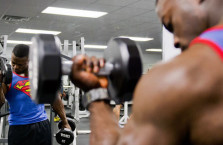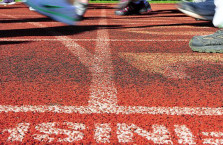Stand up Paddle boarding is a cultural and athletic phenomenon that kick started in Hawaii but today has exploded into mainstream consciousness as a result of its popularity as a fitness tool with a huge range of celebrities. Is paddle boarding a good workout? To begin answering that question we need to look no further than Jennifer Aniston, Rihanna, and Owen Wilson, as well as numerous other Hollywood celebrities, all of whom need to stay tan, fit, and healthy and use paddle boards regularly for this purpose. These celebrities and a number of others have all acknowledged SUPing’s immense fitness potential.
According to professional surfer Sam Hammer, whether one is cruising in an inner bay or blasting through waves, it’s the wobbly board surface, inherently unstable nature of water, and the occasional extra challenge of gusting wind that adds to the difficulty of balancing on a SUP board. This offers a complete full body workout that activates the core as you have to depend on these muscles all the time to stabilize yourself and secure yourself into the deck of the board.
It’s almost as if your core and abdominal muscles are “gripping” the board. In turn, you work on conditioning your back, arms, legs and even your toes and feet while paddling. A good half hour on a paddle board will make your quads and calves sore for sure. Once you get acquainted to SUPing, it’s like any other rigorous exercise – an excellent cardiovascular activity – however it is also uplifting and relaxing in a way few other sports can match.
Core Training Makes Paddle Boarding A Good Workout
The core of your body includes the stomach, lower back and upper thigh region. In other words it is your mid-section that essentially bridges the gap between your upper and lower body while providing foundational strength for the whole body. Unbalanced surfaces are highly effective for training or building up core muscles and so any sport that is dynamic and calls for a lot of stabilization automatically becomes an excellent core training activity. The core muscles are what stabilize you and help grip the deck of the paddle board through your feet. Because that large and complex muscle group is being engaged the entire time one is on the board, paddle boarding gives immense core training benefits.
While traditional resistance training will target each muscle group separately, when you paddle board all the core muscles come into play working together just to keep you standing and dry on your board. As you balance yourself, you are actually moving around your body weight shuffling it between your feet and at the same time using the paddle to exert balancing/propelling force on the uneven water surface. Additionally, to propel and drive the SUP forward, you have to rely on a controlled and coordinated rhythm of paddle strokes.
Quality stroke mechanics involve torso rotation and a unique forward “scooping” motion that engages the core muscles further. This entire process of just propelling the paddle board forward without falling into the water is what strengthens the cores continuously. As we have noted, even standing on the board without momentum is engaging your core, but this is taken to the next level when we begin to propel the board forward.
Stand up Paddling is probably the only sport that appears difficult at first and yet manages to quickly develop amazing and rewarding abilities in beginners in under 10 minutes. Be it children or adults, everyone finds SUPing tricky to start with but will quickly learn to co-ordinate and utilize core muscles to have fun in the water while staying dry and feeling in complete control over the board.
Is Paddle Boarding A Good Workout?
Stand up Paddle boarding is a cultural and athletic phenomenon that kick started in Hawaii but today has exploded into mainstream consciousness as a result of its popularity as a fitness tool with a huge range of celebrities. Is paddle boarding a good workout? To begin answering that question we need to look no further than Jennifer Aniston, Rihanna, and Owen Wilson, as well as numerous other Hollywood celebrities, all of whom need to stay tan, fit, and healthy and use paddle boards regularly for this purpose. These celebrities and a number of others have all acknowledged SUPing’s immense fitness potential.
Fit from paddle boarding
According to professional surfer Sam Hammer, whether one is cruising in an inner bay or blasting through waves, it’s the wobbly board surface, inherently unstable nature of water, and the occasional extra challenge of gusting wind that adds to the difficulty of balancing on a SUP board. This offers a complete full body workout that activates the core as you have to depend on these muscles all the time to stabilize yourself and secure yourself into the deck of the board.
It’s almost as if your core and abdominal muscles are “gripping” the board. In turn, you work on conditioning your back, arms, legs and even your toes and feet while paddling. A good half hour on a paddle board will make your quads and calves sore for sure. Once you get acquainted to SUPing, it’s like any other rigorous exercise – an excellent cardiovascular activity – however it is also uplifting and relaxing in a way few other sports can match.
Core Training Makes Paddle Boarding A Good Workout
The core of your body includes the stomach, lower back and upper thigh region. In other words it is your mid-section that essentially bridges the gap between your upper and lower body while providing foundational strength for the whole body. Unbalanced surfaces are highly effective for training or building up core muscles and so any sport that is dynamic and calls for a lot of stabilization automatically becomes an excellent core training activity. The core muscles are what stabilize you and help grip the deck of the paddle board through your feet. Because that large and complex muscle group is being engaged the entire time one is on the board, paddle boarding gives immense core training benefits.
While traditional resistance training will target each muscle group separately, when you paddle board all the core muscles come into play working together just to keep you standing and dry on your board. As you balance yourself, you are actually moving around your body weight shuffling it between your feet and at the same time using the paddle to exert balancing/propelling force on the uneven water surface. Additionally, to propel and drive the SUP forward, you have to rely on a controlled and coordinated rhythm of paddle strokes.
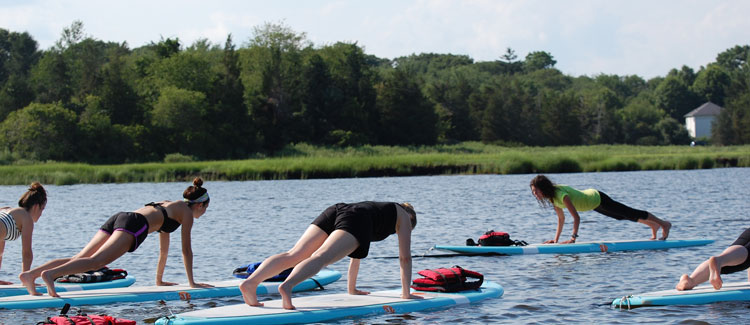
Paddle Board for Exercise
Quality stroke mechanics involve torso rotation and a unique forward “scooping” motion that engages the core muscles further. This entire process of just propelling the paddle board forward without falling into the water is what strengthens the cores continuously. As we have noted, even standing on the board without momentum is engaging your core, but this is taken to the next level when we begin to propel the board forward.
Stand up Paddling is probably the only sport that appears difficult at first and yet manages to quickly develop amazing and rewarding abilities in beginners in under 10 minutes. Be it children or adults, everyone finds SUPing tricky to start with but will quickly learn to co-ordinate and utilize core muscles to have fun in the water while staying dry and feeling in complete control over the board.
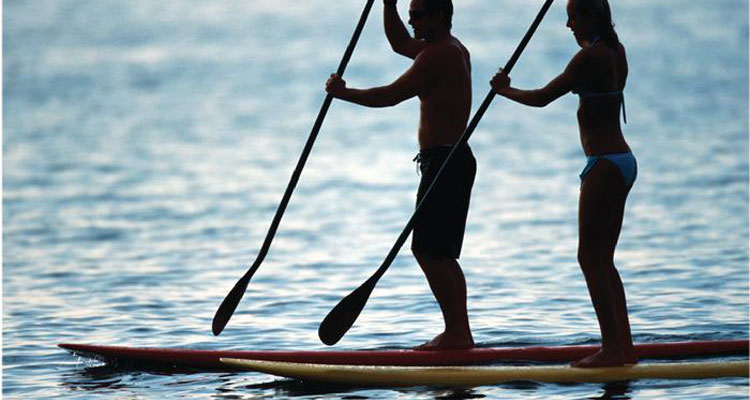
Strength Training With Paddle Boarding
Other than core muscles, paddle boarding is excellent in developing specific muscle groups in the shoulder, upper back and chest region.
Consider the basic paddle stroke: when you raise your arms up in the air with one arm perfectly extended and the other bent, it engages the Deltoid muscles (upper shoulder joint and chest area) into action. Every time you change your guiding hand, a different side of the deltoid muscles gets worked out. This is why it’s important to switch the paddling side from time to time to avoid muscle asymmetries from developing. While underway, as you push and pull at the paddle at the same time to move the paddle board forward, the triceps and upper back are engaged. And finally while bringing back the arms closer to the body to restart a stroke, the Latisimus Dorsi (mid back muscles responsible for the V shape of the back) get exercised. And while our arms and shoulders could certainly do all the work for us in paddling, they are much less efficient than engaging our backs and core muscle groups into the paddle stroke.
By making the “engine” of the stroke our core and our backs, we essentially deliver the power these muscles generated through our arms and shoulders instead of trying to make our more fragile joints do all the work. This helps to avoid overuse injuries that can develop in most other sports that offer anywhere near the same degree of workout intensity and value.
SUP fitness experts and SUP Yoga trainers actually encourage beginners to incorporate these muscle groups into their strokes immediately in order to improve balance and agility. Moreover, for those who really wish to push it, the pectorals (chest muscles) and Biceps can both be engaged in each stroke to add more power and to elongate the power delivery section of the stroke. However, this added zing to your stroke should still ultimately come from your core even though we use the biceps and pectorals to translate that power into the stroke. Placing one foot behind the other further increases the force you exert on your biceps and chest muscles and is a more advanced stance option regularly used by experienced paddlers to up the intensity of their workouts.
Other than the above mentioned paddle board workouts, every specific genre of SUPing has its own set of health benefits. Surfing challenges and engages the leg muscles a lot as they cushion the landings, take the brunt of turbulence from crashing waves, and keep you on the board at all times.
Adventure touring improves cardiovascular fitness with long drawn out cruises on rivers and lakes while race SUPing competitively improves muscle coordination and helps improve muscle response time (fast twitch muscle groups as well as other anaerobic benefits). In the end it really does not matter what kind of SUPing you engage in or wish to try because you will still manage to work out your entire body while having plenty of fun doing it. In the end it’s all about fun, but if we can have fun while getting a great workout, in turn clearing our mind and improving our health, than that makes this amazing sport all the better.
The article is originally from Surfinok.com check out their site for more information on paddleboarding.


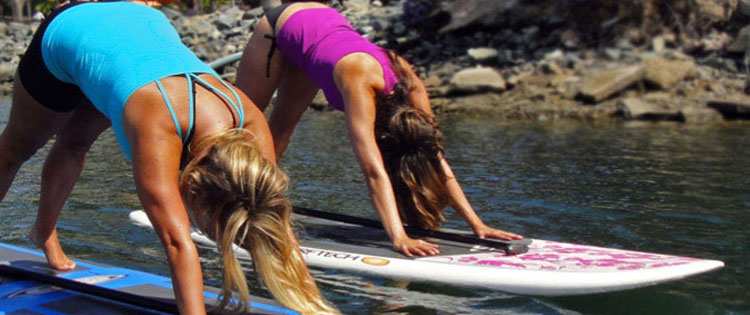


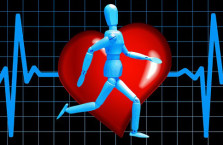
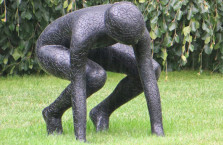


![Morning Kick Start Tips! [VIDEO]](http://FitPhreak.com/wp-content/uploads/2016/06/morning-tips-223x145.jpg)
